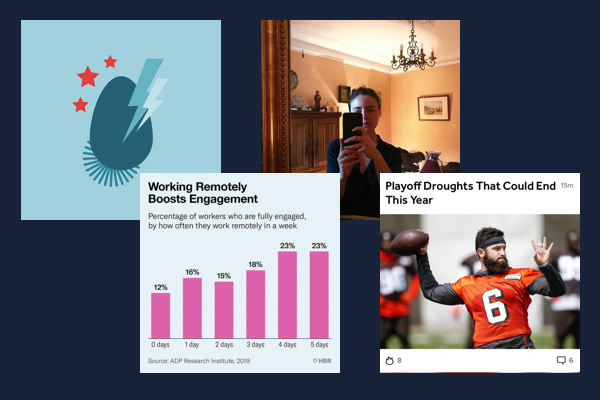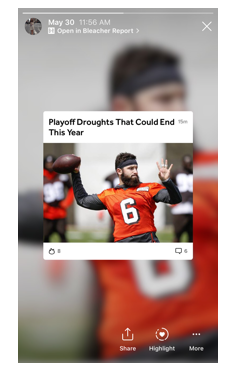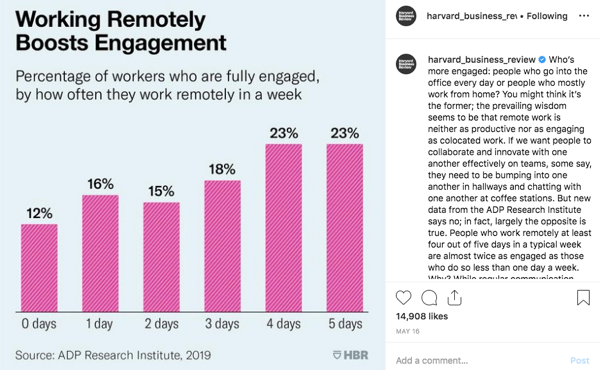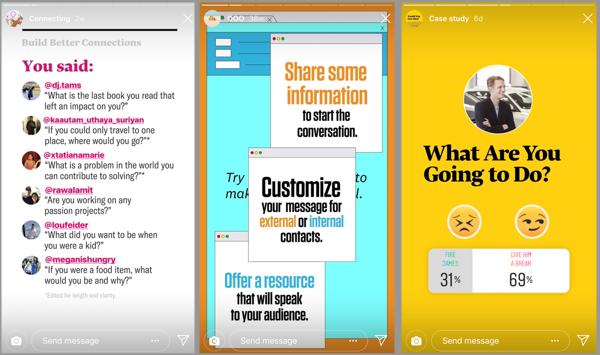Four awesome Instagram strategies for sharing content

Social media teams who focus on content and content distribution have found themselves a little stymied by Instagram, at least if our data is any indication. As of May 2019, Instagram ranks as only the 15th highest source of referral traffic to content and media sites, even though the platform has 1 billion monthly users.
Consumer products, direct to consumer companies, and e-commerce marketers have viewed Instagram as an essential part of their marketing mix. However, the platform hasn’t made it easy to share links, and that’s made it less appealing for content and media teams to adopt. But should you reconsider that stance?
Why promote content on Instagram
A few factors make an Instagram strategy for content worth considering, not the least of which is the 500M daily active users on the platform.
Link in Bio tools make sharing content effective:
Our study on the Link in Bio products shows that though the ease of organically sharing your content doesn’t rival Twitter or Facebook, the effect can still be substantial.
We do and it works amazingly well. Of course would love to have something much more user-friendly but still surprised at how much traffic it can bring.
— Antonio Hontoria (@Hontoria) May 25, 2019
And the companies creating these tools say that their users really see an impact as well. “Linkin.bio tools really allow businesses, brands and publishers the chance to tell a deeper story with Instagram and drive qualified traffic to their website, where conversions can really thrive,” Taylor Loren, Head of Content Marketing at Later, told us.
Rising ad costs make traditional “playbooks” ineffective:
We’re seeing signs that the pure performance marketing paid acquisition programs could become too costly high to make sense for many brands. As more companies borrow from the same playbook, the margins get narrower and harder to justify.
Digiday quoted Henry McNamara, a partner at Great Oaks Venture Capital, in an interview on this topic:
“There’s no longer an arbitrage opportunity to acquire customers online. Things are so saturated and you’re at the mercy of the lowest common denominator — there are brands out there willingly and knowingly overpaying under the guise of acquiring market share and acquiring customers that will repurchase and eventually become profitable, and never will.” – VC Henry McNamara: ‘The term direct-to-consumer is outdated’
Supporting your brand through content:
Even if you don’t view Instagram as a direct traffic driver, that doesn’t mean that it can’t have an impact on your other content channels or goals. Proving that connection just means you have to consider different KPIs than a traditional referral channel.
“From influencers to premium brands: the goal of this platform is community building, not click-through rates.”
my take: treat instagram like a brand flex, not a traffic source. be present with your followers and keep the content there. https://t.co/ffHvTUg3yq
— Adriana Lacy (@Adriana_Lacy) May 24, 2019
Four Instagram content programs to inspire you
We went looking for Instagram initiatives that go beyond paid influencers or advertising. These programs each have different goals, styles, and results, but they each have one thing in common: they use content to connect with an audience.
Company: Clue
Instagram Account: @clueapp | Followers: 57.6K
Goal: App user retention
First, we went looking in our network for a program that’s outperforming others in terms of the percentage of social traffic that comes from Instagram. One client stood out to: Clue, an app for tracking the menstrual cycle and a web resource about reproductive health.
Clue’s Head of Content, Amanda Cormier, told us why her team became interested in the platform: “Instagram is the channel that we’re most excited about for all the reasons other content teams are excited about it—it’s where engaged users of all ages are, and it doesn’t require a huge investment to start seeing results.”
While Clue’s content program overall has a successful search strategy for new user discovery, the team saw that social followers tended to be existing users. The goal of the Instagram strategy focuses on “trying to get [existing users] information that empowers them and builds trust and loyalty to Clue.” Using content and social media for retention and engagement with existing clients means less churn and more lifetime value for customers.

For the last year, Clue’s team focused on driving web traffic through their feed and the Link in Bio feature, which Amanda described as “moderately successful.” Their social manager, Jennifer Neal, also explored making the feed more curatorial by featuring artists who create work about the cycle and bodies; these posts saw high engagement on the platform directly.
Another benefit to investing in their Instagram audience? Jennifer tested and discovered the usefulness of the Q&A feature in stories.
“We asked our followers what questions they had about sperm and eggs, and then abortion—things that they might not feel comfortable asking others about. It’s user-generated content that also helps us find out what content we need to produce in the future. We can’t get this kind of feedback loop on other channels.” – Amanda Cormier, Head of Content, Clue
Amanda’s team took these Q&As to their science team to get answers and posted them in Stories.
Out of the accounts we evaluated, Clue also stood out because of the subject matter they cover: the menstrual cycle. Instagram might be the perfect place for users to engage with a topic that they might otherwise not be willing to post a status update about publicly. If you have content that’s more personal, even if it’s not health related, their strategy could be one to emulate.
Company: Bleacher Report
Instagram: @bleacherreport / Followers: 9.8M
Goal: New app downloads
You would think media companies have a leg up on Instagram because of their huge audiences. However, a high follower count doesn’t always translate into business objectives, which makes investing resources in individual platforms hard to justify.
In the case of Bleacher Report, the reason we’re highlighting their Instagram strategy isn’t because of their own Instagram content. Instead, they looked at the content their app users were sharing: screenshots of the Bleacher Report alerts.
As Tim Peterson of Digdiay reported, this action couldn’t really be tracked by the Bleacher Report team, and they had no way to take advantage of it. They decided to build sharing functionality into the app itself, along with a feature that prompts the followers of their users to download the app.
“When people share a post from Bleacher Report’s app to Instagram Stories, a thumbnail of the post will appear in the story. Atop the post will appear the caption “Open in Bleacher Report” that people can tap on to install or open the app.” – How Bleacher Report is using Instagram Stories for app downloads

Bleacher Report can monetize users on their app: “The app accounts for a large percentage of Bleacher Report’s owned-and-operated audience as well as its owned-and-operated revenue” according to Chris Nguyen, svp of product at Bleacher Report in the Digiday article.
This smart combination of noticing an existing user action on social media led to a product development for a new audience acquisition channel that was previously unreachable. While it’s not a popular term in the media industry, many marketers would refer to this as “growth hacking.”
Are your users taking actions on Instagram that you can tap into?
Company: Vogue, Vogue International
Instagram: @voguemagazine | Followers: 23.3M @vogue | Followers: 384K
Goals: Traffic and building community
Back in late 2017, Abigail Sjoberg, Vogue’s Director of Audience Development, Social Media & Analytics noted that, along with the success they were seeing with Facebook audiences, they were noticing a new source of social media visitors coming from Instagram Stories.
At the time, she said that Instagram was “a bit of an unknown frontier, the data isn’t as great, but we certainly see spikes within Parse.ly when we push something to Instagram stories. It’s starting to become almost as much as some of our smaller social platforms.”
Meanwhile, Abigail had already been studying the differences in how audiences from different channels engaged with content, including “native” readers and search readers, and the team began building strategies for each. As part of the strategy around the large Facebook audience they saw, she had been encouraging the team to create content specifically for social audiences that didn’t necessarily want to read everything Vogue’s core audience wanted.
Watch Abigail’s full presentation on creating content for different audiences here.
Almost two years later, and armed with the data to get catch that trend early, Vogue has seen continued success with Instagram, even as Facebook traffic to most major media sites has dipped. They reported a 130% increase of traffic referred by Instagram back to the site in April of 2018, with 18.5M followers. As of May 2019, they have grown even further to over 23M followers.
However, Vogue has more than one goal with the Instagram audience. Vogue International’s Head of Social Strategy & Storytelling for Vogue International, Hannah Ray, leads an effort to grow community and engagement through the platform as well, using the @vogue handle:
“I know all too well that having high numbers of followers means zilch if none of them actually see or engage with your content, or indeed watch a Story at all. If you don’t know who your community is — having a conversation with people rather than just broadcasting — then you don’t have anything on Instagram.” – How Vogue International implemented a new global Instagram strategy
The @vogue account, unlike the @voguemagazine account, doesn’t link to stories. Instead it reads more like a @humansofny account, but make it fashion.

The company uses two Instagram handles for the separate initiatives, run from the U.S. and the International teams, respectively. If you have the resources, having multiple accounts to reach different goals can allow for clarity in each and a better way to evaluate results.
Company: Harvard Business Review
Instagram: @harvard_business_review | Followers: 956,000
Goals: Traffic (we think)
Ironically, there is no case study available on how Harvard Business Review uses Instagram. According to Forbes, an overall digital marketing program led to an annual increase of 11.8% in paid circulation and an increase of 9.5% in subscriptions from 2017 to 2018.
However, we don’t know exactly how their Instagram content strategy applies to that goal. Still, the account is worth including here for the category of information it shares. Our data from Currents shows that referrals from Instagram tend to send traffic to stories about Style & Fashion, Health & Exercise, Politics, and Sports. Less than 2% of traffic from Instagram goes to content about business, but that’s exactly what Harvard Business Reviews account offers, and offers well.
The account has almost one million followers and an impressive 9000 interactions per post, according to Socialbakers data. It posts about once a day to the main feed, and each post references a specific article, which followers can read more about by using the Link in Bio tool HBR provides. However, the posts don’t just tease the story or even prompt you to use the Link in Bio device. Instead, they each contain a 1500 character or so caption boiling the story down to its essence, which they refer to as “Adapted from…” in the text at the end.

In addition to these feed posts, the HBR account has a set of story highlights can be fully experienced in their own right, though they each include a linked article at the end. Many include interactive elements, including voting on whether you would fire an employee given a set of circumstances, a Q&A feature asking followers how they start conversations with people at work, and plenty of tips you can put into action immediately.

One of the advantages HBR has is the evergreen quality of their articles. Even their “most popular” page shows this, with the stories from the past three years ranking at the top. This means that they likely have a very good idea of which content is worth investing in the graphics and creative for Instagram stories, and then feel comfortable leaving that static for some time.
If you have a smaller content archive, but a very good idea of what your best pieces are though, it’s a great model to experiment with. I also noticed that quickly after following the account I began to see paid ads for HBR courses and products, meaning they’re using their content to help direct ad spend to promote their other products.
So, should you be on Instagram?
Even with these great strategies, there’s no guarantee that Instagram will become your highest place referral traffic.
You may have other goals you want to pursue with your Instagram brand account. Instagram doesn’t have to be a place for promoting content of any type. The decision to invest time, energy, and cost investment in it should be backed by data that shows that your audience might be open to it there, and monitored for the results you want to achieve very closely.
But these accounts prove there are plenty of ways to experiment on the third most popular social network, no matter your audience, content, goals, or team size.